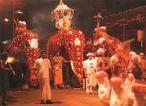Kandy
|
Kandy is a major tourist destination-is also known as the cultural capital of Sri Lanka. Nestled in the hills at an altitude of 488 m, it is located at a distance of 65 km from Spring Acre.
Click below to get driving directions on Google Maps Kandy has a rich history. It was originally known as Senkadagalapura after a hermit named Senkada who lived there. Many of Sinhalese people call it Mahanuwara meaning the Great City. The name Kandy was derived by the colonial rulers from the word Kanda in Sinhala, meaning a hill. Kandy was the stronghold of the Sinhalese kings, who promoted and protected the local culture until the city fell to the British in 1815.
Today a bustling commercial city, Kandy is famous for the Kandy Perahara - a huge cultural pageant that takes place in the month of July or August. It is one of the most colorful processions of the world. Thousands of drummers and dancers accompanying a parade of ornamented elephants perform in the streets of Kandy. The leading tusker carries the sacred tooth relic of Lord Buddha, while the spectators pay homage to it. The procession moves along the streets for seven consecutive nights and concludes on the day of the August full moon. A full day visit is advised to Kandy. Some key attractions for a a day-trip to Kandy are: (1) The Temple of Tooth: Also known as Sri Dalada Maligawa, it is one of the most sacred Buddhist pilgrimage sites in the world. Here, one of the Buddha's teeth is kept. The temple was built in the 17th century. A golden canopy has been added recently. Daily rituals are performed three times a day-at 4.30 a.m., 10.30 a.m., and 6.30 p.m. respectively. (2) Hindu Shrines: There are four Hindu shrines dedicated to Gods Vishnu and Natha and Goddess Patthini in Kandy. Three of them are located adjacent to the Temple of Tooth, while the fourth one is towards the Kandy town. (3) Udawatte Kele: Udawatte Kele is a primeval forest located above the Dalada Maligawa. It is also known as the Forbidden Forest of the Kings of Kandy. It contains a variety of trees such as Talipot trees, cinnamon, olive, rattan cane, betel, bo-trees, kitul palms, jak, mara, betelnut and arecanut. (3) Peradeniya Gardens: The garden-a paradise for nature lovers- was built in 14th century during the reign of king Vikrama Bahu III. The best-known attraction of the garden is the orchid House, which houses more than 300 varieties of exquisite orchids. A spice garden located here gives you a first hand account of the trees and plants used in the traditional Ayurvedic medicine. (4) Embekke Temples: This 14th century temple is famous for the intricate wooden carvings dedicated to God Katargama. Almost the entire structures of some wooden buildings are decorated with dancers, musicians, wrestlers, legendary beasts and birds. Nearby are the ruins of an ancient rest house with similar pillars carved in stone. |




